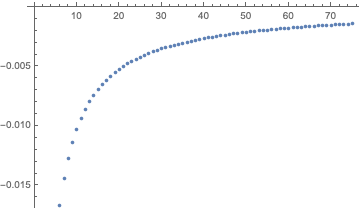$\mathrm G$ is Catalan's constant.
I recently found the product $$ \alpha=\prod_{n=1}^{\infty}\frac{E_n(\frac12)E_n(\frac7{12})E_n(\frac1{20})E_n(\frac{13}{20})}{E_n(\frac14)E_n(\frac1{12})E_n(\frac3{20})E_n(\frac{11}{20})}=\\ \exp\left[\frac{47\mathrm G}{30\pi}+\frac34\right]\sqrt{\frac{33}{91\pi}\sqrt{\frac2\pi\frac{\sqrt[5]{11}}{\sqrt[3]{7}}\sqrt[5]{\frac{3^3}{13^{3}}}}}$$
Where $$E_n(x)=\frac{j(n+x)}{(en)^{2x}j(n-x)}\qquad x\in(0,1)$$ and $j(x)=x^x$.
Could I have some numerical evidence, or better yet an alternate proof? My tools are limited to desmos, which cannot really handle infinite products. Thanks.
My Proof:
We define $$\mathrm L(x)=\frac1\pi\int_0^{\pi x}\log(\sin t)dt$$ And we use $$\sin t=t\prod_{n\geq1}\left(1-\frac{t^2}{\pi^2 n^2}\right)$$ To see that $$\log(\sin t)=\log(t)+\sum_{n\geq1}\log\frac{\pi^2n^2-t^2}{\pi^2n^2}$$ Then integrate both sides over $[0,x]$ to get $$\pi\mathrm L(x/\pi)=x(\log x-1)+\sum_{n\geq1}x\log\bigg(1-\frac{x^2}{\pi^2n^2}\bigg)-2x+\pi n\log\frac{\pi n+x}{\pi n-x}$$ $$\pi\mathrm L(x/\pi)=\log\left[\frac{j(x)}{e^x}\right]+\sum_{n\geq1}\log\left[\frac{j(\pi n+x)}{(e\pi n)^{2x}j(\pi n-x)}\right]$$ $x\mapsto \pi x$: $$\pi\mathrm L(x)=\log\left[\frac{j(\pi x)}{e^{\pi x}}\right]+\sum_{n\geq1}\log\left[\frac{j(\pi n+\pi x)}{(e\pi n)^{2\pi x}j(\pi n-\pi x)}\right]$$ $$\mathrm L(x)=\log\left[\left(\frac\pi{e}\right)^xj(x)\right]+\sum_{n\geq1}\log E_n(x)$$ Then we define $$U(x)=\prod_{n\geq1}E_n(x)$$ To see that $$U(x)=\left(\frac{e}{\pi x}\right)^x\exp\mathrm L(x)$$ Where we used $$\sum_{n}\log(a_n)=\log\left[\prod_{n}a_n\right]$$ and the neat rules $$\log(a^b)=\log(e^{b\log a})=b\log a$$ $$\log(a)\pm b=\log\left(e^{\pm b}a\right)$$ to simplify the expressions. Next, we define $$P_{\mu,\nu}(a_1,a_2,\dots,a_\mu;b_1,b_2,\dots,b_\nu)=\frac{\prod_{i=1}^\mu U(a_i)}{\prod_{i=1}^\nu U(b_i)}$$ And we see that $$P_{\mu,\nu}(a_1,\dots,a_\mu;b_1,\dots,b_\nu)=\prod_{n\geq1}\frac{\prod_{i=1}^\mu E_n(a_i)}{\prod_{i=1}^\nu E_n(b_i)}$$ This gives $$P_{1,1}(x_1;x_2)=\left(\frac{e}{\pi}\right)^{x_1-x_2}\frac{j(x_2)}{j(x_1)}\exp\left[\mathrm L(x_1)-\mathrm L(x_2)\right]$$ Then we define $$\mathrm{T}(x)=\frac{1}{\pi}\int_0^{\pi x}\log(\tan t)dt=\mathrm L(x)-\mathrm L(x+1/2)-\frac12\log2$$ To get that $$P_{1,1}\left(x;x+\frac12\right)=\sqrt{\frac{2\pi}e}\,\frac{j(x+1/2)}{j(x)}\exp\mathrm T(x)$$ So we have $$P_{2,2}\left(x_1,x_2+\frac12 ;x_2,x_1+\frac12\right)=\frac{j(x_1+1/2)j(x_2)}{j(x_2+1/2)j(x_1)}\exp\left[\mathrm T(x_1)-\mathrm T(x_2)\right]$$ Then using the identities $$\mathrm L(1/2)=-\frac12\log2$$ $$\mathrm L(1/4)=\frac{\mathrm G}{2\pi}-\frac14\log2$$ We get $$P_{1,1}\left(\frac12;\frac14\right)=\frac1{(2\pi)^{1/4}}\exp\left[\frac{\mathrm G}{2\pi}+\frac14\right]\tag{1}$$ From here, the identity $$-\mathrm T(1/12)=\frac{2\mathrm G}{3\pi}$$ which gives $$P_{1,1}\left(\frac7{12};\frac1{12}\right)=\sqrt{\frac6{7\pi\sqrt[6]{7}}}\exp\left[\frac{2\mathrm G}{3\pi}+\frac12\right]\tag{2}$$ Then from here, the identity $$\mathrm T(1/20)-\mathrm T(3/20)=\frac{2\mathrm G}{5\pi}$$ gives $$P_{2,2}\left(\frac1{20},\frac{13}{20};\frac3{20},\frac{11}{20}\right)=\left(\frac{j(11)j(3)}{j(13)}\right)^{1/20}\exp\frac{2\mathrm G}{5\pi}\tag{3}$$ Then multiplying $(1),(2),$ and $(3)$, we have the desired result, namely $$P_{4,4}\left(\frac12,\frac7{12},\frac1{20},\frac{13}{20};\frac14,\frac1{12},\frac3{20},\frac{11}{20}\right)=\alpha$$

